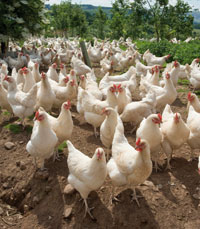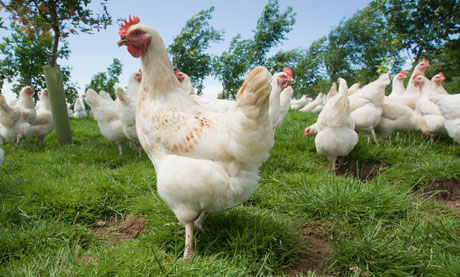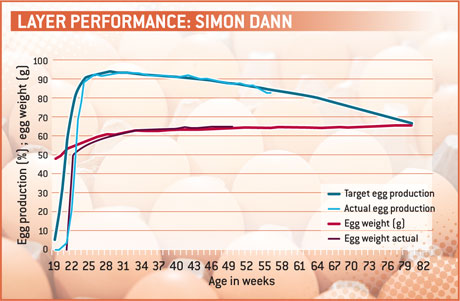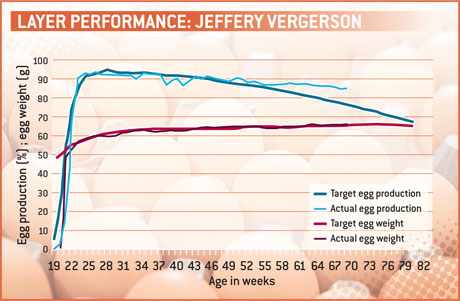White brown-egg layer proving popular with free-range farmers

A reverse-cross white layer breed with exceptional feathering qualities is finding favour among some free-range producers, especially where the birds are on view to the public.
If you’re searching for a brown egg layer that looks good, ranges freely and offers the chance for an extended laying period, then the Dekalb Amberlink could be just what you’re looking for.
Producers who farmed in the 1970s will remember the Amberlink, which originated in the USA. But in Europe, the breed was eventually replaced by smaller, cage-orientated strains in the 1980s, although it remained widespread in South Africa and other countries with a requirement for large, robust birds.
The first Amberlink parent stock were reintroduced to the UK in 2007, says Peter Cumbers, of the breed’s sole distributor, Joice and Hill. He believes that the secret of the Amberlink’s excellent feather retention lies in its colour.
“Even with the best management, birds can lose feather cover and start to look scruffy,” says Mr Cumbers. “On a brown bird with white under-feathers, any slight loss of feathering will reveal the white feathers below. The contrasting colours encourage other birds to peck at its feathers, making the situation worse. This is less likely to happen with the Amberlink, because it’s an all-white bird.”

The Dekalb Amberlink ranges away from its housing in all weathers
Mr Cumbers accepts that eggs from the Amberlink are smaller than average, but points out that the bird has other traits that make up for it.
“Feedback suggests that producers with Amberlinks will see fewer seconds in the packing station,” he says. “The birds have excellent ranging abilities, and will also maintain a good level of production, laying for up to 80 weeks without loss of efficiency. And their solid feathering gives a thick coverage, which can be an advantage in naturally-ventilated housing, especially during the winter.”
The average consumer is likely to judge the standard of care provided by a free-range egg producer according to the look of the birds, and that includes feathering, says Mr Cumbers. The public also expects to see free-range hens spread over the entire area of available grassland.
As the number of free-range egg sales rises, and at a time when the industry is being subjected to ever-increasing scrutiny, the Amberlink’s good feathering and ranging traits will become more important, he adds.
Although there are only a small number of flocks in this country, Mr Cumbers sees a bright future ahead for the breed.
“Where producers want to combine good visual impact with dark brown eggs and long-lasting shell quality, the Dekalb Amberlink offers an interesting alternative to the mainstream breeds,” he concludes.
Case study: Simon Dann, North Tuddenham, Norfolk
For the past two decades, Simon Dann has kept a free-range flock, which he runs alongside his farm contracting business. He also makes ice-cream from his 120-cow dairy herd, selling the product under the Norfolk Farmhouse Ice Cream banner.
As a producer who has always enjoyed experimenting with new products, Mr Dann has tried a number of different types of bird over the years. In November 2007, he took delivery of 8000 Amberlinks, with the breed making up half of his total flock numbers.
Right from the start, the birds made a good impression, settling well and ranging away from the housing in all weathers. Floor eggs were almost non-existent. The Amberlinks peaked at 93%, and were still achieving 87.4% at 51 weeks old. Egg size topped 65.6g (see graph).
The first Amberlink flock was, unfortunately, challenged by disease. Under normal conditions. Mr Dann thinks they would have carried on performing well at the 75-80 week stage.

“We were running at less than 1% seconds, which is a huge achievement. This level of saleable eggs more than compensates for lower-than-average egg weights, in my opinion,” says Mr Dann.
Unsurprisingly, the farm is now running an exclusively Amberlink flock. A couple of weeks after his second batch arrived, he had not lost a single bird. To reduce any potential risk of smothering, he has installed extra perches in the housing.
As a further precaution, staff at the rearing unit have made a point of going into the sheds several times a day to replenish the feed. This has proved successful, says Mr Dann, who reports that the birds are very quiet, and used to human company.
“Our birds are not in the public eye, but that might change in the future, as there are times, such as open days, when we will have visitors. Consumers don’t expect to see free-range hens that are bald, which can sometimes happen when hens are pushed to lay bigger eggs,” he says.
Case study: Jeff Vergerson, Holt, North Norfolk
As well as working as a consultant for Noble Foods, Jeff Vergerson runs two separate organic units, totalling 15,000 layers. His site at Howton has nine sheds, each containing 700 birds. Meanwhile at Horsford, there are three sheds of 3000 birds, one of which is devoted to Amberlinks.
Having managed the birds for 12 months, Mr Vergerson is full of praise for the Amberlinks. He says their ranging ability is second to none and his flock has been very healthy. With some of the fields at Horsford in full view of a number of public roads, the Amberlink’s feather retention capacity has proved to be a real bonus.
“As a poultry producer, the sight of my birds in full feather, and ranging free in the fields adds to my job satisfaction. I also have a responsibility to make sure that the public’s perception of our production methods is one of good management and high welfare standards.

“Brown birds, even when they are managed well and are in the best of health, can start to look a little scruffy at certain times of the year. Most members of the public would not appreciate this factor, and it would be easy for people to jump to the conclusion that the birds were not being properly managed.”
Despite his obvious appreciation of the breed’s positive attributes, Mr Vergerson reports two slight drawbacks – smothering and egg size.
“We don’t usually get any problems with smothering, but there have been incidents with the Amberlink, so mortality rates have been higher.
“Their egg size is probably about 2g lighter than average. But we have found that the birds will continue to lay at an acceptable rate for six to eight weeks longer than our other breeds. This additional production period means that their overall financial contribution is about equal, and it also helps in a small way with cash flow.
“If the company can rectify the egg size issue, and manage to breed out the smothering trait, we could see the Amberlink gaining in popularity,” says Mr Vergerson.
More information about the Dekalb Amberlink can be found on the Joice and Hill website, www.chickandegg.com or by phoning 01733 221 833.
